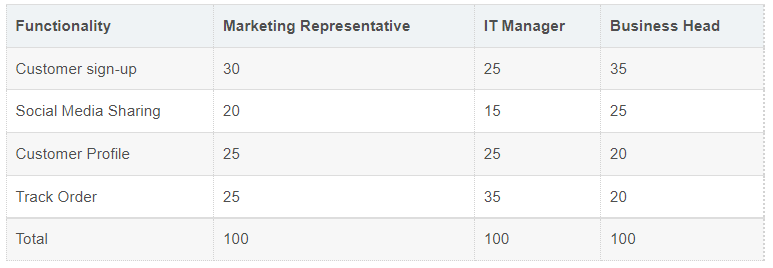Ważne jest, aby priorytetyzować swój backlog produktu, aby nie stał się on otwartą listą, na której każdy ma losowe pomysły dotyczące twojego produktu. Twoja lista zadań musi być uporządkowana, zorganizowana i priorytetyzowana, aby zidentyfikować najważniejsze strategicznie rzeczy do zrobienia przez twój zespół. W tym artykule przedstawiam metodę 100 punktów do działań związanych z udoskonalaniem backlogu produktu.

Czym jest metoda procentowa?
Metoda 100 punktów (znana również jako metoda 100 dolarów, suma stała lub stała alokacja) została zaproponowana przez Deana Leffingwella i Dona Widriga w 2003 roku. Celem jest nadanie większej wagi przedmiotom o wyższym priorytecie niż inne dostępne historie użytkowników. Obejmuje to przyznanie uczestnikom 100 punktów. Mogą głosować na przedmioty w liście zadań produktu, takie jak epiki lub historie użytkowników, które dodają największą wartość dla biznesu. Głosy nie muszą być równomiernie rozdzielone; zamiast tego wyższy priorytet niektórych projektów może być odzwierciedlony przez ważoną alokację. Po zakończeniu procesu głosowania priorytet określa się poprzez obliczenie łącznej liczby punktów przyznanych każdej historii użytkownika.
Jak działa metoda 100 punktów?
Jak wspomniano powyżej, metoda 100 punktów pozwala uczestnikom przyznać 100 punktów w celu określenia priorytetu różnych projektów. Oceny wyrażane są jako procent, a najpopularniejsze wybory są klasyfikowane wyżej.
Oto przykład podejścia 100/100 punktów do rozwijania nowych stron e-commerce:

Wyobraź sobie grupę ludzi próbujących priorytetyzować pięć przedmiotów.
- 100 punktów na osobę.
- Jedna osoba może zdecydować, że każdy projekt jest równie ważny i przyznać 20 punktów każdemu projektowi.
- Lub mogą uznać projekt 1 za ważniejszy niż projekt 2, projekt 2 za ważniejszy niż projekt 3, i tak dalej. W rezultacie ich głosy zostały przydzielone na podstawie wagi, z 40 głosami uzyskanymi w przypadku 1, 30 głosami w przypadku 2, 15 głosami w przypadku 3, i tak dalej, aż wszystkie głosy zostały przydzielone.
- Wszystkie karty do głosowania są następnie sumowane, aby określić ostateczny głos dla każdego przedmiotu, co skutkuje listą priorytetów.
Podsumowanie
Czasami to podejście nazywane jest również metodą stałej lub stałej alokacji, ponieważ gdy dajemy uczestnikom ten sam zestaw przedmiotów i prosimy ich o przyznanie 100 punktów przedmiotom backlogu produktu na podstawie ich względnego znaczenia.
Musimy rozważyć zalety i wady przy podejmowaniu decyzji priorytetowych. Im więcej punktów zdobywa jedna osoba, tym mniej punktów zdobywa druga. Czy ten demokratyczny proces głosowania gwarantuje jakość decyzji? To naprawdę zależy od jakości i inteligencji zespołu.
Ponieważ metoda 100 punktów zapewnia stałą sumę, potrzebuje poprawnej kolejności priorytetów, aby być uznaną za ważną. W przeciwnym razie konieczne będą pewne procedury walidacyjne, ale może to być warte wysiłku i można to również zrobić za pomocą niektórych narzędzi programowych.
- Czym jest backlog produktu w Scrumie? Kto jest za to odpowiedzialny?
- Jak udoskonalić backlog produktu?
- Czym jest backlog sprintu w Scrumie?
- Jak priorytetyzować backlog produktu, używając metody MoSCoW
- Jak priorytetyzować backlog produktu, używając metody 100 punktów?
- Czym jest cel sprintu w Scrumie?
- Czym jest wykres burndown w Scrumie?
- Czym jest szablon Rola-Cecha-Powód?
- Przyrost sprintu vs potencjalny produkt do wysyłki vs MVP vs MMP
- Napisz cele SMART i INVEST dla historii użytkowników
Ten post dostępny jest również w Deutsch, English, Español, فارسی, Français, Bahasa Indonesia, 日本語, Portuguese, Ру́сский, Việt Nam, 简体中文 and 繁體中文













